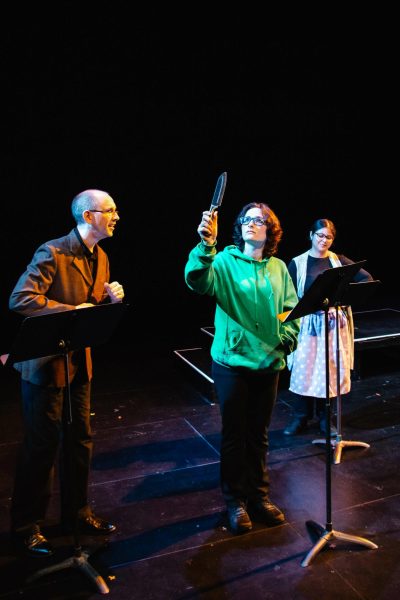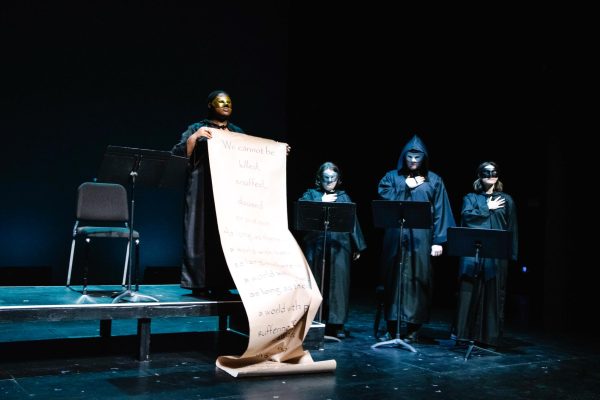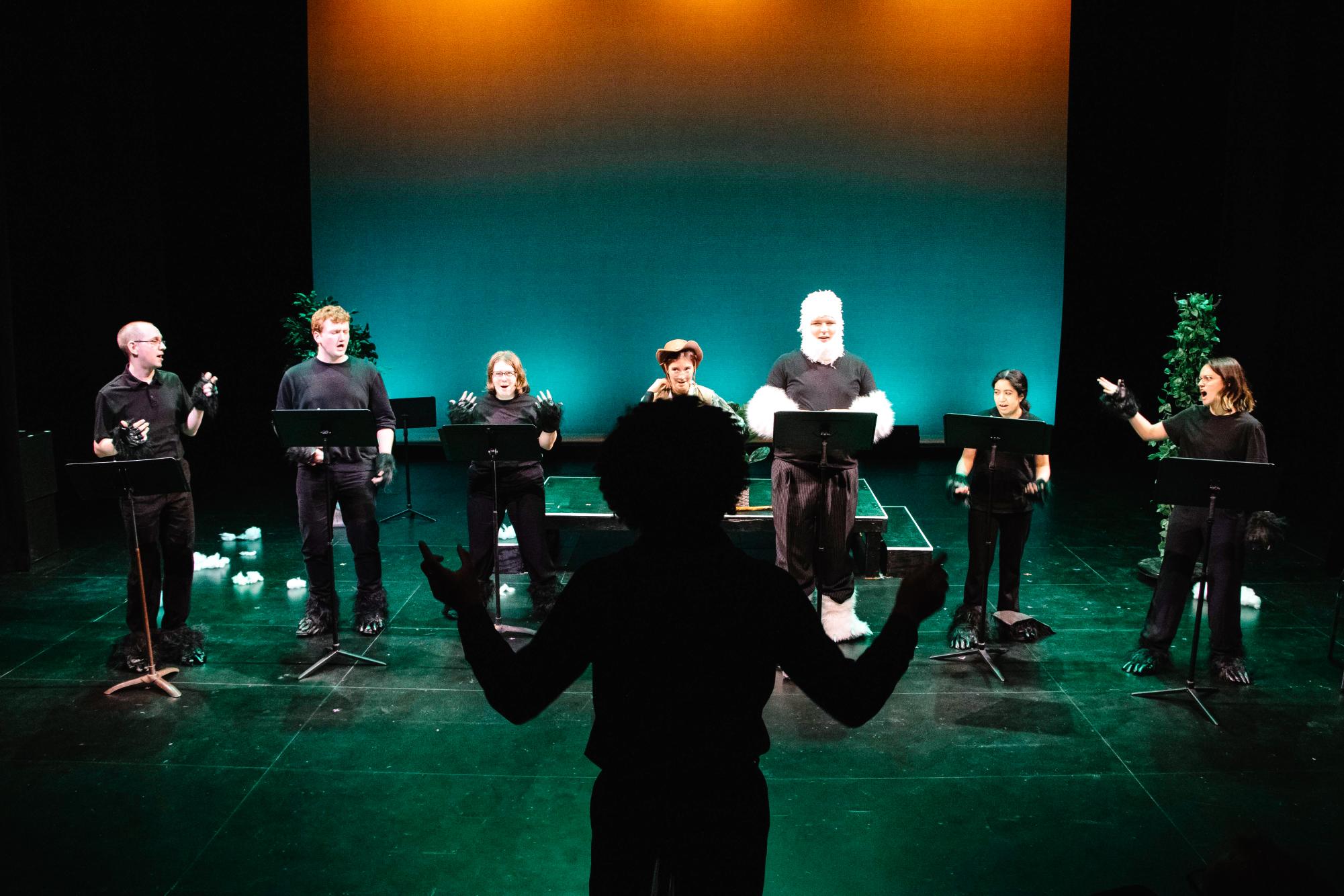Students performed “New Voices, New Stories: A Celebration of UMass Boston Student Playwrights,” a collection of seven student-written plays featuring staged readings and two audience talkbacks, in the University Hall Theater Oct. 3-5.
The shows focused on the composition and content of the plays, rather than just the actors’ performance, highlighting potential issues in the scripts that need to be addressed. There were minimal set pieces on stage, and actors wore simple costumes while carrying a copy of the script. A member of the cast also sat to the side of the stage, reading the play’s stage directions to the audience.
This year, “New Voices, New Stories” welcomed more opportunities to celebrate student voices. For the first time, students Nakatto Nassozi and Anna Pumphrey joined UMass Boston Theatre Arts professor Carrie Ann Quinn in directing the plays.
Nassozi directed the showcase’s first play. “All Assholes Assemble” by Meghan Geslin acted as a profound social commentary on society’s lack of action when addressing global issues. The powerful message was only elevated by Nassozi’s directing position.
The play follows AAA members Things 2, 3 and 4 as they summarize their recent nefarious misdeeds to their leader, Thing 1. Equality, Diversity and Inclusivity, who infiltrated the meeting, confront them. However, these “Things” are really the grim realities plaguing society: Exploitation, Segregation, Persecution and Discrimination. The AAA questions the three’s lack of progress in society. Equality, Diversity and Inclusivity then directly address the audience’s participation in complacency.
“Two Plots,” the second play, was written by Pumphrey. The story centers on a young woman named Penny and a man named Rogers. He reveals that he has been long dead and that Penny has joined him in the afterlife, taking the grave plot next to him that his wife should have been in.
Pumphrey’s inspiration for “Two Plots” came from an online post about a man who “reserved two gravesites for him and his wife.” After his death, his wife remarried and was buried next to her new husband. This caused Pumphrey to “ponder the way humans experience grief and death, and what that might look like in the afterlife.”
“It was a much more vulnerable experience to turn over my own work into the hands of the Director, Carrie Ann,” Pumphrey said. “I trusted her completely to tell my story and I believe she did a fantastic job of conveying what it was meant to.”
Megan Feudo’s “Teenage Dream” is a lighthearted comedy about a teenage girl, her three toys and her no-good ex-boyfriend. The play begins with Katie’s toys, Pinky, Hippo and Barbie, as they celebrate her break-up with Michael. Their glee doesn’t last, as Katie can’t seem to cut him out of her life. When the toys see Michael calling another girl in Katie’s room, they can no longer restrain their rage and unleash their fury to the background track of Taylor Swift’s “Vigilante S—.”

The fourth play, “I’d Like to Imagine the Unimaginable” by Laura Melo dos Santos, stood out among all the plays with its portrayal of mourning and loss. Directed by Pumphrey, the play conveyed how mood disorders like depression can result in the idealization of death.
“This was my first opportunity to direct in this way,” Pumphrey said. “While it was challenging to take on such a heavy and poignant show, the support and encouragement of my mentors in the Performing Arts Department helped me to feel empowered and ready for that challenge.”
She added that, “For this play, it was imperative to create a safe and welcoming environment in which the student actors could feel comfortable and inspired to participate to their fullest extent.”
In the first scene, a husband intently reads through a letter while his wife stares absently at a photo frame on the table. At the end of the scene, the photo frame is flipped to show the couple with their son. The second scene takes the audience back to the son writing a letter to his parents, implying what may have happened beforehand.
Denis Lemus’s “Andy vs. The Play” hilariously breaks the fourth wall as the titular character, Andy, gains the ability to see the audience and hear the narrator after falling from a cliff. From a plot-convenient fan being rolled out by a member of the stage crew to the narrator trying to prevent Andy from meddling, shenanigans ensue.
Vanessa Elizabeth Medeiros’s “Chained Confessions” reflected on the importance of taking control of one’s own life, regardless of fear. The play follows J, who has been forced into a life of labor. Chained to a bed during the night, J is visited by two strange girls, who try to convince J to escape. J refuses out of fear for what their handler, Tud, will do to them and their mother, but when Tud returns in the morning, J realizes that they missed any opportunity to leave.
The final play, “Ohio James” by Leo Khomiakov, centers on Indiana Jones’s cousin, Ohio James, who works at Walmart and is constantly pestered by his mother about wasting his doctorate in psychology. Fed up with his cousin’s fame, he journeys to the jungle to search for the Yeti. In the jungle, he befriends five gorillas and even the Yeti itself, who help him to defeat the narrator — who is actually Indiana Jones. At the play’s conclusion, the cast of the play comes together to sing the “Ohio James Theme Song.”
Alecto Llamas played the role of Ohio James, as well as Diversity and Barbie in earlier plays.
“Each character was very different, and so working on all three was fun and certainly challenging in terms of making them all feel distinct,” Llamas said. “Ohio James was definitely my favorite role. The first time we ran the song was so much fun, I could barely keep from laughing long enough to finish it.”

This article appeared in print on Page 1 of Vol. LVIII Issue V, published Oct. 21, 2024.


